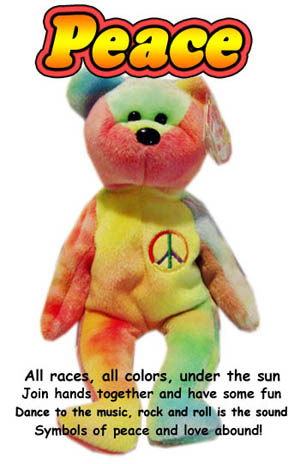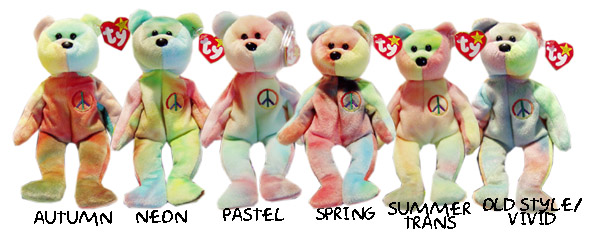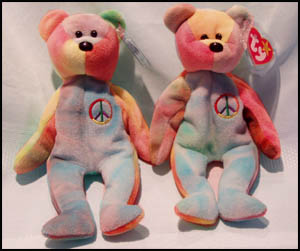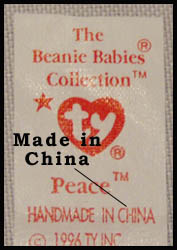
Ty got a lot of things right in the 90s… and ty-dye fabric was one of them.
Peace has got to be one of the top 3 most recognizable Beanie Babies of all time from a mainstream perspective.
It just fit the 90s so perfectly and was always a fan favorite – especially with the different variations.
Peace made its debut on May 11, 1997, captivating collectors with its vibrant tie-dyed design and quickly becoming a coveted item among enthusiasts. The allure of these unique ty-dyed bears led many collectors to amass extensive collections, with some individuals boasting hundreds of variations.
Each Peace bear is distinct, showcasing its own unique pattern, rendering the task of collecting them akin to an art form and posing a considerable challenge for enthusiasts. The forthcoming pages aim to provide guidance on identifying Peace bears through various methods, facilitating a deeper understanding and appreciation of these cherished collectibles.
Identifying The Different Types Of Peace Bear Variations

Classifying Peace Bears by their colors poses a considerable challenge due to the subjective nature of color perception. Over time, six main color categories for Peace Bears have been established: Autumn, Neon, Pastel/Whitewashed, Spring, Summer Transitional, and Vivid. However, categorizing each bear into its respective color group can be difficult as individual interpretations of color vary. Here’s a breakdown of each color category and the types of Peace Bears that typically fit into them:
- Autumn Bears: Characterized by darker hues, particularly deep browns and greens resembling camouflage, Autumn Bears emerged on the market between September 1998 and January 1999. These bears often bear tush tag numbers such as 100, 101, 102, 112, 113, 115, 116, 120, and 121, with 115 being the most common.
- Neon Bears: Known for their vibrant, almost glowing colors, Neon Bears started appearing in the spring of 1998, shortly after Ty corrected spelling errors on tags. Neon Bears usually have no number inside their tush tag or are marked with a #102.
- Pastel/Whitewashed Bears: Highly sought after, Pastel Peace Bears are subject to debate regarding their true appearance. Typically, Pastel Bears lack dark colors entirely, with no browns present. They often bear tush tag numbers 101 or 102, and Indonesian Pastel Peace Bears are particularly rare and highly coveted. Whitewashed Bears, even lighter than Pastel versions, feature areas on their fabric that appear almost white.
- Spring Bears: From February 1999 until the retirement of the Peace Bear, those on the market were classified as Spring Bears. These bears have fewer browns and olive/dark greens compared to Autumn Bears, with brighter hues. Common tush tag numbers for Spring Bears include 101, 102, 110, 111, 112, 115, 116, and 119, with 112 and 115 being the most prevalent.
- Summer Transitional Bears: A cross between Vivid and Neon, Summer Transitional Bears were prominent during the summer of 1998. They often bear tush tag numbers 102, 107, 108, 110, 114, 115, 116, and 119, with the all-caps “TY INC.” and a 1996 date on their tags.
- Vivid Bears: The earliest Peace Bears released fall into this category, characterized by darker colors reminiscent of Garcia Bears but with Peace symbols. Most Vivid Bears have PVC pellets and 4th generation hang tags, some with 5th generation tags and PE pellets in early 1998. They usually feature the Fareham, Hants Ty Europe location inside their hang tags and have distinctively scrunchy faces.
- Solids & Pajama Peace Bears: Bears are sometimes categorized as solid or pajama based on the color of their front side. Solid-colored bears, particularly rare and highly sought after, have a uniform color across their front, extending partially down their arms and legs, resembling pajamas. The exact definition of a solid color varies among collectors, with no precise percentage requirement for uniformity.
- Solid Blue Peace Bear – Mostly blue, see below.

Variations In Peace Hang Tags, Tush Tags, and Stamps
An increasingly popular method of categorizing and collecting Peace Bears revolves around a small red stamp found inside their tush tags. This stamp typically indicates the factory where the bear was manufactured, likely serving as part of Ty Inc.’s quality control process. However, it’s important to note that Peace Bears with Indonesia tags do not bear this stamp, and not all bears made in China will have it either. The introduction of these stamps coincided with the rollout of 6th generation tags, appearing on Peace Bears around June of 1998.
These red stamps can feature various numbers, including 100, 101, 102, 107, 108, 110, 111, 112, 113, 114, 115, 116, 119, 120, and 121. Naturally, some numbers are considered more rare than others. Among the stamp numbers, 102 and 115 are the most common, while numbers like 108, 113, and 114 are considered the most rare.


Peace Bears Checklist PDF
How Much Is My Peace Beanie Baby Worth?
Back in the 90s, these peaked around $25-35 but were always beloved. Unfortunately, like every 4th Generation (or newer) Beanie Baby, there just is no collectible / resale value for Peace today.
